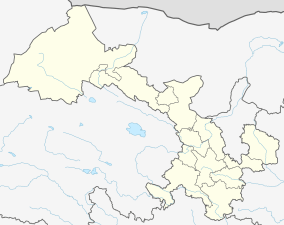Zhelaizhai
Zhelaizhai (simplified Chinese: 者来寨; traditional Chinese: 者來寨; pinyin: Zhěláizhài) is a village on the edge of the Gobi desert in Gansu province, China. The area was renamed after Liqian, an ancient county,[1] and is located in Jiaojiazhuang township,[2] Yongchang County. Some of the modern-day residents of Zhelaizhai, now known as Liqian village,[1] have been suspected to be descendants of a group Roman soldiers that were never accounted for after being captured in the Battle of Carrhae. Although this story has been seized upon by enthusiastic area residents and non-specialist Westerners, at least two eminent Chinese authorities have shown that the notion has serious shortcomings.[3][4][5][6]
Zhelaizhai 者来寨 | |
|---|---|
 Zhelaizhai Location in Gansu  Zhelaizhai Zhelaizhai (China) | |
| Coordinates: 38°15′00″N 101°58′11″E | |
| Country | China |
| Province | Gansu |
| District | Jinchuan |
| Time zone | UTC+8 (China standard time) |
Lost Romans myth
.png)
Zhelaizhai received much attention from international media and researchers due to a hypothesis which states that its inhabitants may have descended from the Romans. The area of the former Liqian County is known for the distinctive physical appearance of its inhabitants. The population has higher frequencies of traits prevalent in Europe, such as aquiline noses, blonde or light-colored hair, blue or green eyes, and relatively fair skin tones. In the 1940s, Homer H. Dubs, a professor of Chinese history at the University of Oxford, suggested that the people of Liqian were descended from Roman legionaries taken prisoner at the Battle of Carrhae. Several investigations of Dubs' theory have been conducted.[7] To date, no artifacts which might confirm a Roman presence, such as coins or weaponry, have been discovered in Zhelaizhai.[8] Rob Gifford, commenting on the theory, described it as one of many "rural myths".[9]
The history records of the town indicate that it was founded by captured combatants of the Battle of Zhizhi during 36 BC. A geography book of the eastern Han Dynasty records that "Local people call the ancestors of the Roman prisoners-of-war Lijian", a Chinese term for being of Greco-Roman origin.[10][11]
People with normatively Caucasoid traits and/or who spoke Indo-European languages lived in areas that are now part of Gansu and Xinjiang centuries before the Romans, including the Yuezhi, Wusun, Basmyls, Tocharians, and some prehistoric Siberian populations.[12] One or more of these peoples may have been responsible for the Caucasoid Tarim mummies of Xinjiang. Genetic testing in 2005 revealed that 56% of the DNA of some Zhelaizhai residents could be classified as Caucasoid but did not determine their origins.[13] A subsequent DNA study in 2007 found that "paternal genetic variation" did not support "a Roman mercenary origin" and that the modern population of Liqian was consistent genetically with it being a "subgroup of the Chinese majority Han."[14][15][16]
Geography
Zhelaizhai lies in the Hexi Corridor in the northern region of China, on the eastern edge of the Gobi Desert.[7][17] It is rural, with the nearest city being 300 kilometres (190 mi) distant.[7]
See also
References
- 者来寨、骊靬古城遗址、骊靬亭简介 (in Chinese). Yongchang County Bureau of Culture, Radio, Television. 8 August 2013.
- 2016年统计用区划代码和城乡划分代码 (in Chinese). National Bureau of Statistics of the People's Republic of China. 2016.
- Hoh, Erling (14 January 1999). "Lost Legion". Far Eastern Economic Review. pp. 60–62.
- "Do descendants of Roman soldiers live in Gansu?". China Daily. 21 July 1998.
- Ying-shih, Yu (1967). Trade and Expansion in Han China: A Study in the Structure of Sino-Barbarian Economic Relations. Berkeley: University of California Press. pp. 89–91.
- I-tien, Hsing (1997). 漢代中國與羅馬帝國關係的再檢討 (1985-95) [Relations between Han China and the Roman Empire Revisited (1985-95)]. Chinese Studies (漢學研究) (in Chinese). 15 (1): 1–31.
- Spencer, Richard (3 February 2007). "DNA tests for China's legionary lore". The Sydney Morning Herald. Retrieved 5 February 2007.
- Squires, Nick (23 November 2010). "Chinese villagers 'descended from Roman soldiers'". The Telegraph. Retrieved 25 November 2010.
- Gifford, Rob (29 May 2007). "We Want to Live!". China Road: A Journey Into the Future of a Rising Power. New York: Random House. p. 185. ISBN 1-4000-6467-8.
- France, Duncan (31 January 2014). "A Roman Legacy in China?". New Zealand China Friendship Society.
- Beijing Review. 47 (21). 27 May 2004.
- Keyser, Christine; Bouakaze, Caroline; Crubézy, Eric; et al. (September 2009). "Ancient DNA provides new insights into the history of south Siberian Kurgan people". Human Genetics. 126 (3): 395–410. doi:10.1007/s00439-009-0683-0. PMID 19449030.
- "Hunt for Roman Legion Reaches China". China Daily. 20 November 2010. Retrieved 4 June 2012.
- Zhou, Ruixia; An, Lizhe; Wang, Xunling; et al. (June 2007). "Testing the hypothesis of an ancient Roman soldier origin of the Liqian people in northwest China: a Y-chromosome perspective". Journal of Human Genetics. 52 (7): 584–591. doi:10.1007/s10038-007-0155-0. PMID 17579807.
- Spencer, Richard (2 February 2007). "Roman descendants found in China?". The Telegraph.
- Zhou, Ruixia; et al. (June 2007). "Testing the hypothesis of an ancient Roman soldier origin of the Liqian people in northwest China: a Y-chromosome perspective". Journal of Human Genetics. 52 (7): 584–591. doi:10.1007/s10038-007-0155-0. PMID 17579807.
- "Scientists Take DNA from Chinese Villagers in Hopes of Solving Roman Mystery". Fox News. 5 February 2007. Retrieved 5 February 2007.